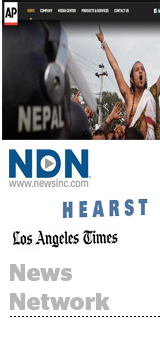 Atlanta-based News Distribution Network (NDN) is the quiet video engine that hums behind a host of traditional and new media publisher sites like the New York Daily News, Los Angeles Times and Hearst.
Atlanta-based News Distribution Network (NDN) is the quiet video engine that hums behind a host of traditional and new media publisher sites like the New York Daily News, Los Angeles Times and Hearst.
Last March, Yahoo CEO Marissa Mayer contemplated a $300 million bid to buy NDN following its interest in French web video platform Dailymotion, but those deals never panned out. (Yahoo bought video marketplace BrightRoll later that fall.)
NDN’s longtime chairman, CEO and founder, Greg Peters, declined to comment on the reported acquisition, but said his company has remained self-sufficient and serves a variety of publishers.
“Publishers want video sourced where an event is actually happening with local flavor and coverage that presents the best point of view without necessarily being tied to a brand,” he said. “We are brand neutral for advertisers, publishers and content partners, but at the same time we have partnered with the big boys like AOL at one time, Yahoo, Microsoft, Cox, McClatchy and Hearst.”
In 2010, NDN absorbed operations for The Associated Press’ 1,500-member Online Video Network. The sales, licensing and distribution agreement gave NDN exclusive rights to monetize all video clips from AP member companies through 2017.
“It’s kind of the Wild West in the video space and we feel like we survived a lot of attrition because the AP really gave us the market,” Peters said.
NDN also syndicates 4,000 videos a day through its Digital Media Exchange, drawing from its network of 400 affiliate partners like Comcast, Bloomberg and CBS.
About 4,000 national, regional and local publishers including the Los Angeles Times and the New York Daily News, embed its video player on their sites.
Its video ads appear on about eight billion pages per month, Peters estimated.
Peters says NDN’s video player and ads typically run in-line and are embedded within related content on the publisher’s page. Because of its relationship with the AP, it can match article text and content from the major news wires with relevant videos.
NDN says one of its key differentiators is connecting regional publishers with ad requests from national advertisers, given its AP affiliation.
In that instance, it acts as a rep firm, selling local inventory down to the local or regional level, partnering with individual publishers to help them achieve the best rates for their inventory. When working with a publisher’s direct sales team, the general rule is NDN wins the higher CPM while carving out room for local partners to fill.
If, for instance, the Atlanta Journal’s sales teams sold a local ad, they would be able to run those ads in front of NDN’s videos for free, but in general Peters said NDN sells 95% of the ads that run across its partner sites.
A majority of NDN’s business is focused on the sell side (it uses Google DFP as its ad server and SpotX as its supply-side platform). But it has relationships with most of the large agencies and trading desks who want to target video ads against its publishers’ demographic data set (affluent, news-consuming adults age 35-54 who are higher educated) through private exchanges.
“We give them all the data they need on completion rates, click through rates and screen shots of where their ads run,” Peters said. “We are very transparent about giving all our site lists for our publishers because there’s nothing to hide there. We feel we bring a very strong value proposition that eliminates many of the middlemen in the process.”
NDN says it is focusing on publisher’s needs around mobile, personalization and automation.
One premium publisher who uses NDN’s video player, and who requested to go unnamed, says it also accesses NDN’s video syndication network. Because it ran into some volume issues in its own direct sales efforts (it simply didn’t produce enough video to meet the demand) NDN opened up a viable monetization route.
“To date, it’s been pretty successful,” the source said. “We’re pretty heavily embedded with them and it’s providing substantial revenue for us on a monthly and annual basis to make it worthwhile as a partner.”
The source said it took a while for NDN to enable HTML5 videos to play on a mobile-optimized site. However, that was “understandable” given NDN’s stance as a network with many individual publisher sites it plugs into, each with different development requirements.
That publisher also used an incumbent video player prior to NDN, but noted the costs were “prohibitive.” Still, the source’s ad ops team needed to “jury rig” some technical capabilities in order to improve the workflow from the time the ad server receives a request to when a relevant ad was surfaced.
The constant challenge for publishers is balancing the volume of video they can effectively monetize while refraining from cluttering up the UX. But because younger demographics have heavy video consumption habits, publishers are clamoring for more ways to augment Millennial-focused video.
“We saw NBC putting an equity stake in BuzzFeed and Vox – there’s this feeding frenzy that Disney maybe started last year,” Peters said. “The consumption on mobile and social has exploded, so that’s the accelerator of this viral impact a lot of people are looking at with these investments.”
In July, NDN had 24.2 million unique video views on desktop, a 38% decrease from 39.4 million a year ago, according to comScore. Although it’s a sizable drop, Adam Lella, a comScore marketing insights analyst, said he’s seen similar declines on other properties as audiences begin to view more video on mobile.
Despite the dip in desktop views, NDN has generated “very strong revenue over the past five years,” according to Peters. Consequently, it’s avoided taking private equity or venture capital money to date, instead backed by a formidable roster of private investors like Google chairman Eric Schmidt and actor Bill Murray.













